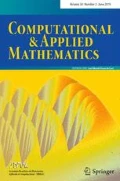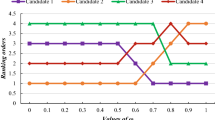Abstract
Information reliability has a remarkable effect on decision-making outcome. Zadeh’s Z-number considers information fuzziness and reliability, and can, therefore, help the decision-maker to manage complicated problems. However, due to its complex construct, several issues concerning the computation of Z-numbers require further research. This study develops a novel likelihood-based method of comparing two Z-numbers to solve multi-criteria decision-making (MCDM) problems. Four main parts can be outlined. First, the likelihood of fuzzy restriction of Z-numbers is defined based on the conversion method of Z-number. Second, the likelihood of underlying probability distributions of Z-numbers is also proposed to compare the difference of randomness of Z-information. Third, by adding to a risk preference parameter, this study constructs a comprehensive weighted likelihood of Z-numbers. Finally, a likelihood-based qualitative flexible approach is extended to address the MCDM problems under Z-evaluation. In addition, a numerical example of the selection of ERP systems for ABC enterprise is placed to illustrate the applicability, validity, and effectiveness of the proposed method.



Similar content being viewed by others
References
Aliev RA, Alizadeh AV, Huseynov OH (2015) The arithmetic of discrete Z-numbers. Inf Sci 290(C):134–155
Aliev RA, Huseynov OH, Zeinalova LM (2016) The arithmetic of continuous Z-numbers. Inf Sci 373(C):441–460
Aliyev RR (2016) Multi-attribute decision making based on Z-valuation. Procedia Comput Sci 102(C):218–222
Atanassov KT (1986) Intuitionistic fuzzy sets. Fuzzy Sets Syst 20(1):87–96
Buckley JJ (1988) Possibilistic linear programming with triangular fuzzy numbers. Fuzzy Sets Syst 26(1):135–138
Chen S-H (1985) Ranking fuzzy numbers with maximizing set and minimizing set. Fuzzy Sets Syst 17(2):113–129
Chen Y-H, Wang T-C, Wu C-Y (2011) Strategic decisions using the fuzzy PROMETHEE for IS outsourcing. Expert Syst Appl 38(10):13216–13222
Chen S-X, Wang J-Q, Wang T-L (2019) Cloud-based ERP system selection based on extended probabilistic linguistic MULTIMOORA method and Choquet integral operator. Comput Appl Math 38(2):88
Chou C-C (2003) The canonical representation of multiplication operation on triangular fuzzy numbers. Comput Math Appl 45(10–11):1601–1610
Cuong BC, Kreinovich V (2013) Picture fuzzy sets—a new concept for computational intelligence problems. In: 3rd world congress on information and communication technologies (WICT 2013). IEEE, pp 1–6
Gao F-J (2013) Possibility degree and comprehensive priority of interval numbers. Syst Eng Theory Pract 33(8):2033–2040
Hu J-H, Yang Y, Zhang X-L, Chen X-H (2018) Similarity and entropy measures for hesitant fuzzy sets. Int Trans Oper Res 25(3):857–886
Hu J, Zhang X, Yang Y, Liu Y, Chen X (2020) New doctors ranking system based on VIKOR method. Int Trans Oper Res 27(2):1236–1261
Jaynes ET (1957) Information theory and statistical mechanics. Phys Rev 106(4):620–630
Ji P, Zhang H-Y, Wang J-Q (2019) A fuzzy decision support model with sentiment analysis for items comparison in e-commerce: the case study of PConline.com. IEEE Trans Syst Man Cybern Syst 49(10):1993–2004
Kang B, Wei D, Li Y, Deng Y (2012a) Decision making using Z-numbers under uncertain environment. J Comput Inf Syst 8(7):2807–2814
Kang B, Wei D, Li Y, Deng Y (2012b) A method of converting Z-number to classical fuzzy number. J Inf Comput Sci 9(3):703–709
Kang B, Chhipi-Shrestha G, Deng Y, Hewage K, Sadiq R (2018a) Stable strategies analysis based on the utility of Z-number in the evolutionary games. Appl Math Comput 324:202–217
Kang B, Deng Y, Hewage K, Sadiq R (2018b) Generating Z-number based on OWA weights using maximum entropy. Int J Intell Syst 33(8):1745–1755
Kang B, Deng Y, Sadiq R (2018c) Total utility of Z-number. Appl Intell 48(3):703–729
Kang B, Deng Y, Hewage K, Sadiq R (2019) A method of measuring uncertainty for Z-number. IEEE Trans Fuzzy Syst 27(4):731–738
Liang R, Wang J (2019) A linguistic intuitionistic cloud decision support model with sentiment analysis for product selection in E-commerce. Int J Fuzzy Syst 21(3):963–977
Peng H-G, Wang J-Q (2017) Hesitant uncertain linguistic Z-numbers and their application in multi-criteria group decision-making problems. Int J Fuzzy Syst 19(5):1300–1316
Peng H-G, Wang J-Q (2018a) A multicriteria group decision-making method based on the normal cloud model With Zadeh's Z-numbers. IEEE Trans Fuzzy Syst 26(6):3246–3260
Peng H-G, Wang J-Q (2018b) Outranking decision-making method with Z-number cognitive information. Cognit Comput 10(5):752–768
Peng H-G, Shen K-W, He S-S, Zhang H-Y, Wang J-Q (2019a) Investment risk evaluation for new energy resources: an integrated decision support model based on regret theory and ELECTRE III. Energy Convers Manage 183:332–348
Peng H-G, Wang X-K, Wang T-L, Wang J-Q (2019b) Multi-criteria game model based on the pairwise comparisons of strategies with Z-numbers. Appl Soft Comput 74:451–465
Peng H-M, Wang X-K, Wang T-L, Liu Y-H, Wang J (2020a) A multi-criteria decision support framework for inland nuclear power plant site selection under Z-information: a case study in Hunan province of China. Mathematics 8(2):252
Peng J-J, Tian C, Zhang W-Y, Zhang S, Wang J-Q (2020b) An integrated multi-criteria decision-making framework for sustainable supplier selection under picture fuzzy environment. Tech Econ Dev Econ. https://doi.org/10.3846/tede.2020.12110
Qiao D, Shen K-W, Wang J-Q, Wang T-l (2019a) Multi-criteria PROMETHEE method based on possibility degree with Z-numbers under uncertain linguistic environment. J Ambient Intell Hum Comput 11(5):2187–2201
Qiao D, Wang X-K, Wang J-Q, Chen K (2019b) Cross entropy for discrete Z-numbers and its application in multi-criteria decision-making. Int J Fuzzy Syst 21(6):1786–1800
Rashid T, Faizi S, Xu Z, Zafar S (2018) ELECTRE-based outranking method for multi-criteria decision making using hesitant intuitionistic fuzzy linguistic term sets. Int J Fuzzy Syst 20(1):78–92
Shannon CE (1948) A mathematical theory of communication. Bell Syst Tech J 27(3):379–423
Shen K-W, Wang J-Q (2018) Z-VIKOR method based on a new weighted comprehensive distance measure of Z-number and its application. IEEE Trans Fuzzy Syst 26(6):3232–3245
Shen K-W, Wang X-K, Wang J-Q (2019a) Multi-criteria decision-making method based on smallest enclosing Circle in incompletely reliable information environment. Comput Ind Eng 130:1–13
Shen K, Wang X, Qiao D, Wang J (2019b) Extended Z-MABAC method based on regret theory and directed distance for regional circular economy development program selection with Z-information. IEEE Trans Fuzzy Syst. https://doi.org/10.1109/TFUZZ.2019.2923948
Singh P (2017) Distance and similarity measures for multiple-attribute decision making with dual hesitant fuzzy sets. Comput Appl Math 36(1):111–126
Smarandache F (2010) Neutrosophic logic—generalization of the intuitionistic fuzzy logic. Extr Metall Nickel Cobalt Platin Group Metals 269(51):49–53
Song C, Wang J, Li J (2020) New framework for quality function deployment using linguistic Z-numbers. Mathematics 8(2):224
Tavakkoli-Moghaddam R, Sotoudeh-Anvari A, Siadat A (2015) A multi-criteria group decision-making approach for facility location selection using PROMETHEE under a fuzzy environment. In: Kamiński B, Kersten GE, Szapiro T (eds) Outlooks and insights on group decision and negotiation: 15th international conference, GDN 2015, Warsaw, Poland, June 22–26, 2015, Proceedings. Springer International Publishing, Cham, pp 145–156
Tian Z-P, Wang J, Wang J-Q, Chen X-H (2018) Multicriteria decision-making approach based on gray linguistic weighted Bonferroni mean operator. Int Trans Oper Res 25(5):1635–1658
Tian C, Peng J, Zhang W, Zhang S, Wang J (2020a) Tourism environmental impact assessment based on improved AHP and picture fuzzy PROMETHEE II methods. Technol Econ Dev Econ 26(2):355–378
Tian Z-P, Nie R-X, Wang J-Q, Luo H, Li L (2020b) A prospect theory-based QUALIFLEX for uncertain linguistic Z-number multi-criteria decision-making with unknown weight information. J Intell Fuzzy Syst 38(2):1775–1787
Torra V (2010) Hesitant fuzzy sets. Int J Intell Syst 25(6):529–539
Verma R, Merigó JM (2019) On generalized similarity measures for Pythagorean fuzzy sets and their applications to multiple attribute decision-making. Int J Intell Syst 34(10):2556–2583
Verma R, Sharma BD (2014) A new measure of inaccuracy with its application to multi-criteria decision making under intuitionistic fuzzy environment. J Intell Fuzzy Syst 27(4):1811–1824
Wang J, Wang J-Q, Tian Z-P, Zhao D-Y (2018) A multi-hesitant fuzzy linguistic multicriteria decision-making approach for logistics outsourcing with incomplete weight information. Int Trans Oper Res 25(3):831–856
Wang X, Wang J, Zhang H (2019) Distance-based multicriteria group decision-making approach with probabilistic linguistic term sets. Expert Syst 36(2):e12352
Wang L, Wang X, Peng J, Wang J (2020a) The differences in hotel selection among various types of travellers: a comparative analysis with a useful bounded rationality behavioural decision support model. Tour Manag 76:103961
Wang L, Zhang H-Y, Wang J-Q, Wu G-F (2020b) Picture fuzzy multi-criteria group decision-making method to hotel building energy efficiency retrofit project selection. RAIRO Oper Res 54(1):211–229
Xu Z-S (2001) Algorithm for priority of fuzzy complementary judgement matrix. J Syst Eng 16(4):311–314
Yaakob AM, Gegov A (2016) Interactive TOPSIS based group decision making methodology using Z-numbers. Int J Comput Intell Syst 9(2):311–324
Yager RR (2012a) On Z-valuations using Zadeh's Z-numbers. Int J Intell Syst 27(3):259–278
Yager RR (2012b) On a view of Zadeh’s Z-numbers. In: Greco S, Bouchon-Meunier B, Coletti G, Fedrizzi M, Matarazzo B, Yager RR (eds) Advances in computational intelligence: 14th international conference on information processing and management of uncertainty in knowledge-based systems, IPMU 2012, Catania, Italy, July 9–13, 2012, Proceedings, Part III. Springer, Berlin, Heidelberg, pp 90–101
Yang Y, Wang J-Q (2018) SMAA-based model for decision aiding using regret theory in discrete Z-number context. Appl Soft Comput 65:590–602
Zadeh LA (1965) Fuzzy sets. Inf Control 8(3):338–353
Zadeh LA (1999) Fuzzy sets as a basis for a theory of possibility. Fuzzy Sets Syst 100:9–34
Zadeh LA (2011) A note on Z-numbers. Inf Sci 181(14):2923–2932
Zhang H, Dong Y, Herrera-Viedma E (2018) Consensus building for the heterogeneous large-scale GDM with the individual concerns and satisfactions. IEEE Trans Fuzzy Syst 26(2):884–898
Zhou H, Wang J-Q, Zhang H-Y (2019) Stochastic multicriteria decision-making approach based on SMAA-ELECTRE with extended gray numbers. Int Trans Oper Res 26(5):2032–2052
Acknowledgements
The authors are very grateful to the anonymous reviewers for their valuable comments and suggestions to help improve the overall quality of this paper. This work was supported by the National Natural Science Foundation of China (No. 71871228).
Author information
Authors and Affiliations
Corresponding author
Ethics declarations
Conflict of interest
The authors declare no conflict of interests regarding the publication of this paper.
Additional information
Communicated by Rosana Sueli da Motta Jafelice.
Publisher's Note
Springer Nature remains neutral with regard to jurisdictional claims in published maps and institutional affiliations.
Appendix I: Proof of the properties in Property 3
Appendix I: Proof of the properties in Property 3
Proof
-
1.
According to Properties 1 and 2, \(0 \le L^{f} \left( {Z_{1} \succ Z_{2} } \right) \le 1\) and \(0 \le L^{p} \left( {Z_{1} \succ Z_{2} } \right) \le 1\) exists. In addition, \(L\left( {Z_{1} \succ Z_{2} } \right) = \omega L^{f} \left( {Z_{1} \succ Z_{2} } \right) + \left( {1 - \omega } \right)L^{p} \left( {Z_{1} \succ Z_{2} } \right)\). Therefore, \(0 \le L\left( {Z_{1} \succ Z_{2} } \right) \le 1\) can be proven.
-
2.
From Properties 1 and 2, \(L^{f} \left( {Z_{1} \succ Z_{2} } \right) + L^{f} \left( {Z_{2} \succ Z_{1} } \right) = 1\) and \(L^{p} \left( {Z_{1} \succ Z_{2} } \right) + L^{p} \left( {Z_{2} \succ Z_{1} } \right) = 1\) exist. Moreover, \(L\left( {Z_{1} \succ Z_{2} } \right) = \omega L^{f} \left( {Z_{1} \succ Z_{2} } \right) + \left( {1 - \omega } \right)L^{p} \left( {Z_{1} \succ Z_{2} } \right)\). Thus, \(L\left( {Z_{1} \succ Z_{2} } \right) + L\left( {Z_{2} \succ Z_{1} } \right) = 1\) can be obtained.
-
3.
Based on Definitions 7, 8, and 9, if \(Z_{1}\) and \(Z_{2}\) are the same, then both the likelihoods of fuzzy restriction and underlying probability distributions are the same between two Z-numbers. Therefore, \(L\left( {Z_{1} \succ Z_{2} } \right) = L\left( {Z_{2} \succ Z_{1} } \right) = 0.5\).
Rights and permissions
About this article
Cite this article
Qiao, D., Wang, Yt., Wang, Jq. et al. Likelihood-based qualitative flexible approach to ranking of Z-numbers in decision problems. Comp. Appl. Math. 39, 134 (2020). https://doi.org/10.1007/s40314-020-01167-x
Received:
Revised:
Accepted:
Published:
DOI: https://doi.org/10.1007/s40314-020-01167-x




